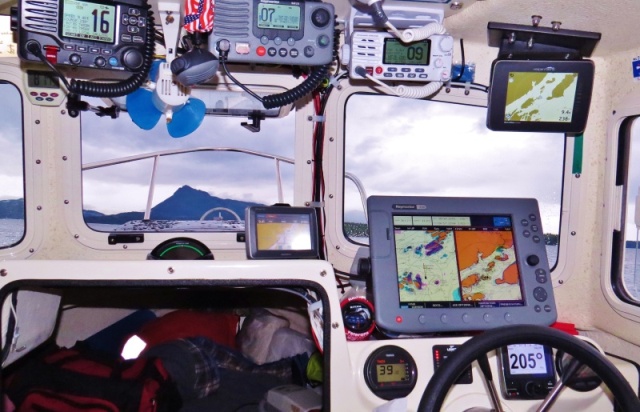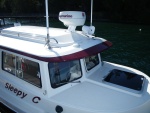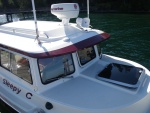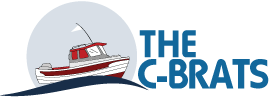| View previous topic :: View next topic |
| Author |
Message |
pcg
Joined: 31 Aug 2018
Posts: 417
City/Region: Sherwood
State or Province: OR
C-Dory Year: 1999
C-Dory Model: 22 Cruiser
Vessel Name: C-Quest
Photos: pcg
|
 Posted: Sun Jun 06, 2021 12:14 am Post subject: Why so many radios? Posted: Sun Jun 06, 2021 12:14 am Post subject: Why so many radios? |
 |
|
I'm new to cruising so am naive about radios. I see lots of pictures of boats that have appear to have two or three radios mounted on the ceiling. Why is there a need for more than one high power VHF at the helm? (I understand the value of having a portable VHF in a ditch bag.)
_________________
Paul |
|
| Back to top |
|
 |
garyf
Joined: 01 Sep 2015
Posts: 167
City/Region: Lincoln
State or Province: CA
C-Dory Year: 1991
C-Dory Model: 22 Cruiser
Vessel Name: C-Story
Photos: C-Story
|
 Posted: Sun Jun 06, 2021 1:46 am Post subject: Re: Why so many radios? Posted: Sun Jun 06, 2021 1:46 am Post subject: Re: Why so many radios? |
 |
|
| pcg wrote: | | I'm new to cruising so am naive about radios. I see lots of pictures of boats that have appear to have two or three radios mounted on the ceiling. Why is there a need for more than one high power VHF at the helm? (I understand the value of having a portable VHF in a ditch bag.) |
I'm sure there's more than one answer to this very valid question - but in my case at least, they aren't all Marine VHF radios. A fair number of cruisers are also ham radio operators (me included) and one or more of those radios are ham radios. That gives us redundancy for multiple means and channels of communication and in some cases longer range. VHF marine is line of sight that only works over a few miles depending on conditions and height of the antenna at each end of the conversation. Some ham radio bands can communicate significantly further.
_________________
Gary Frerking
C-Story
'91 22 ft Cruiser
'08 Yamaha 90
KC3PO |
|
| Back to top |
|
 |
hardee
Joined: 30 Oct 2006
Posts: 12637
City/Region: Sequim
State or Province: WA
C-Dory Year: 2005
C-Dory Model: 22 Cruiser
Vessel Name: Sleepy-C
Photos: SleepyC
|
 Posted: Sun Jun 06, 2021 3:34 am Post subject: Posted: Sun Jun 06, 2021 3:34 am Post subject: |
 |
|
Paul Good question and as Gary mentioned there is more than one answer.

In my case, my boat came set up for fishing and had top of the line everything EXCEPT a decent VHF radio. That was my first purchase was a second VHF. Same brand, (Raymarine), but it had more capability, (auto fog horn and hailer) which in my area is essential, BUT, it also gave me capability to have continuous monitoring on ch16, and be able to go to other channels, for other uses and still have fully functional 16 or if I had to be using the fog horn, I could use the other radio for 16 monitoring. I also generally monitor the Vessel Traffic Channel for the area I am in, (could be any one of 3 here).
If I am traveling with a partner boat, we will frequently go to an unbusy channel and use more radio time and avoid the "official 3 call initiation" for each piece of conversation. For those uses, I frequently use the handheld VHF for very low power, and still have the other ones on for the "business" use.
The first "toy radio" was replaced with one that would receive AIS when that service became available as a "receive" function in the VHF fixed mounts. It also has a speaker function in the mic, so if there is an issue with hearing the station the mic can be held up by my ear and I don't have to mess with turning up the volume for a quick call.
Then along came ICOM with not only AIS receive, fog/hailer function, but with a "Last Call, 2 minute recording" feature. Whatever channel it is set at, it records the last 2 minutes of that call. I added that (ICOM M-505) for that feature alone and use it exclusively for monitoring ch16 now. That feature has been useful several times when folks tend to get excited about something. It can listen and record faster than I can listen, and its a 1 or 2 button action to get back to that message.
Yes, I have heard all about how you can set one radio to scan 2 or a dozen channels, but while that scan is going on you could miss an important part or all of a message on (for instance) channel 16, or a call on 13. Who knows, until you actually hear the difference. Then again, there is that redundancy thing.
Harvey
SleepyC 

_________________
Though in our sleep we are not conscious of our activity or surroundings, we should not, in our wakefulness, be unconscious of our sleep. |
|
| Back to top |
|
 |
hardee
Joined: 30 Oct 2006
Posts: 12637
City/Region: Sequim
State or Province: WA
C-Dory Year: 2005
C-Dory Model: 22 Cruiser
Vessel Name: Sleepy-C
Photos: SleepyC
|
 Posted: Sun Jun 06, 2021 3:34 am Post subject: Posted: Sun Jun 06, 2021 3:34 am Post subject: |
 |
|
Sorry, It's that double redundancy thing going on.
Harvey
SleepyC 
 |
|
| Back to top |
|
 |
colbysmith
Joined: 02 Oct 2011
Posts: 4916
City/Region: Madison
State or Province: WI
C-Dory Year: 2009
C-Dory Model: 25 Cruiser
Vessel Name: C-Traveler
Photos: C-Traveler and Midnight-Flyer
|
 Posted: Sun Jun 06, 2021 1:30 pm Post subject: Posted: Sun Jun 06, 2021 1:30 pm Post subject: |
 |
|
| I have two radios and a handheld. When traveling on many of our rivers, 13 is used for commercial traffic. (Tugs). 14 is used by many if not most locks for recreational vessels. 16, well you know about that. Then if I"m traveling with a buddy, we have our own shared frequency. So I routinely will set one radio to monitor 13 and dual watch on 16. The other radio is set to maybe 69 or 71 for chatter with the buddy. And then the handheld gets used with the lock tender while I'm driving from the cockpit helm or handling lines in the lock. On the Great Lakes, 9 is commonly used as the hailing frequency. And every marina seems to have their own local frequency. Colby |
|
| Back to top |
|
 |
thataway
Joined: 02 Nov 2003
Posts: 21355
City/Region: Pensacola
State or Province: FL
C-Dory Year: 2007
C-Dory Model: 25 Cruiser
Vessel Name: thataway
Photos: Thataway
|
 Posted: Sun Jun 06, 2021 5:48 pm Post subject: Posted: Sun Jun 06, 2021 5:48 pm Post subject: |
 |
|
I'll tell my story: Many years ago, I was taking a 62' ketch, 7' draft thru an area on The Atlantic Coast ICW, called the "Rock Pile". Mandatory hail on Channel 16 and 13 giving securite' upon entering the narrow cut. I had given my hail on both channels. No response. I proceeded. About mid point. I met a tug with several barges. The commercial vessel had the right of way. I had to reverse a few hundred yards and put my boat against a bank so the tug with barge could inch by. In our discussions it was apparent that he was giving his hail on 16 precisely when I was on 13, and visa versa. The working channel may be commercial traffic on a canal, waterway or in a harbor--usually it is 12 or 13, but others are used.
Since then I have always had two VHF high powered radios, plus a couple of handhelds. There are multiple other scenarios which can happen. I have seen many of them since I have been running at least 2 VHF radios.
You might say, Dual watch, or scan. Well radios lock on conversations, and again you may miss a distress's or security call. I always monitor 16 and what commercial channel is in use in the area. Plus if with others, then 68 or other ship to ship channels, on 3rd radio.
Ditch bag today should have a DSC enabled radio, with the MMSI number entered, so it works. You also want the radio to run on alkaline or LI rechargeable AA or AAA batteries, if the built in battery fails. If you don't understand DSC--please do read up on it. Great safety feature.
Also a Personal Locator Beacon in the ditch bag. The PLB uses EPRIB frequencies and contacts SAT SAR satellites for emergencies of peril of life or vessel.
Yep, I am a ham radio operator, and ran VHF, UHF, Marine SSB (Sea 223, modified to transmit and receive by the factory on all frequencies--including Ham and Commercial, as well as CG recognized). Plus a HAM SSB radio, and variety of antennas. I ran daily Maritime mobile on nets for over 8 years total, and then another half a dozen years from my home base with a 60' tower and multi element beam--Lineal Amp.
73's
_________________
Bob Austin
Thataway
Thataway (Ex Seaweed) 2007 25 C Dory May 2018 to Oct. 2021
Thisaway 2006 22' CDory November 2011 to May 2018
Caracal 18 140 Suzuki 2007 to present
Thataway TomCat 255 150 Suzukis June 2006 thru August 2011
C Pelican; 1992, 22 Cruiser, 2002 thru 2006
Frequent Sea; 2003 C D 25, 2007 thru 2009
KA6PKB
Home port: Pensacola FL |
|
| Back to top |
|
 |
pcg
Joined: 31 Aug 2018
Posts: 417
City/Region: Sherwood
State or Province: OR
C-Dory Year: 1999
C-Dory Model: 22 Cruiser
Vessel Name: C-Quest
Photos: pcg
|
 Posted: Sun Jun 06, 2021 8:36 pm Post subject: Posted: Sun Jun 06, 2021 8:36 pm Post subject: |
 |
|
Great responses! Thank you! I'm taking all of these to heart.
How useful is a SSB amateur radio? (I have a current amateur license, but have not operated for over 40 years when I was strictly QRP CW.) Is it possible to find one's self in a location in the Columbia River, Salish Sea, or the Inside Passage (locations where we plan to cruise) where VHF would not be adequate to raise someone? My impression is that those areas are pretty densely populated with marine traffic and I could always raise someone via VHF. Is that true? |
|
| Back to top |
|
 |
thataway
Joined: 02 Nov 2003
Posts: 21355
City/Region: Pensacola
State or Province: FL
C-Dory Year: 2007
C-Dory Model: 25 Cruiser
Vessel Name: thataway
Photos: Thataway
|
 Posted: Sun Jun 06, 2021 9:31 pm Post subject: Posted: Sun Jun 06, 2021 9:31 pm Post subject: |
 |
|
| pcg wrote: | Great responses! Thank you! I'm taking all of these to heart.
How useful is a SSB amateur radio? (I have a current amateur license, but have not operated for over 40 years when I was strictly QRP CW.) Is it possible to find one's self in a location in the Columbia River, Salish Sea, or the Inside Passage (locations where we plan to cruise) where VHF would not be adequate to raise someone? My impression is that those areas are pretty densely populated with marine traffic and I could always raise someone via VHF. Is that true? |
One of the best sources of information on the Inland passage is on 75 meters SSB. There are also 2 meter nets on Vancouver Island. When we were cruising the inland passage we checked in at least once a day, often twice a day. This was run by the Poulsbo Yacht club. Not sure what is available currently. There are several "Bush nets" in AK. Thru the different nets we met in person many most interesting people, including a winner of the Iditarod Race who became a close friend. Often we would meet hams along the way.
On the Maritime Service Net (20 meters) and WW Maritime nets we affected several rescues. When cruising in remote areas.
A creative ham operator uses all resources together to get thru, especially when emergencies loom.
When we were going up and down the ICW, we would check into each repeater, as maritime mobile. This invariably got responses--often a night a a Ham's dock, or offer of a ride to the store.
No Ham radio does not replace VHF. But it adds a wonderful new dimension to cruising in the wonderful C Dory. |
|
| Back to top |
|
 |
pcg
Joined: 31 Aug 2018
Posts: 417
City/Region: Sherwood
State or Province: OR
C-Dory Year: 1999
C-Dory Model: 22 Cruiser
Vessel Name: C-Quest
Photos: pcg
|
 Posted: Sun Jun 06, 2021 10:11 pm Post subject: Posted: Sun Jun 06, 2021 10:11 pm Post subject: |
 |
|
Great info Bob. Thank you so much!
Paul |
|
| Back to top |
|
 |
garyf
Joined: 01 Sep 2015
Posts: 167
City/Region: Lincoln
State or Province: CA
C-Dory Year: 1991
C-Dory Model: 22 Cruiser
Vessel Name: C-Story
Photos: C-Story
|
 Posted: Sun Jun 06, 2021 10:26 pm Post subject: Posted: Sun Jun 06, 2021 10:26 pm Post subject: |
 |
|
| For the people running multiple Marine VHF radios... what are you doing to avoid damage and/or de-sense to the receiving units when you transmit from another unit in close proximity? Multiple antennas, spread them out and hope for the best or using some sort of multiplexer? |
|
| Back to top |
|
 |
colbysmith
Joined: 02 Oct 2011
Posts: 4916
City/Region: Madison
State or Province: WI
C-Dory Year: 2009
C-Dory Model: 25 Cruiser
Vessel Name: C-Traveler
Photos: C-Traveler and Midnight-Flyer
|
 Posted: Sun Jun 06, 2021 10:50 pm Post subject: Posted: Sun Jun 06, 2021 10:50 pm Post subject: |
 |
|
| My antennnas are about 5' apart. Never been a problem. Colby |
|
| Back to top |
|
 |
thataway
Joined: 02 Nov 2003
Posts: 21355
City/Region: Pensacola
State or Province: FL
C-Dory Year: 2007
C-Dory Model: 25 Cruiser
Vessel Name: thataway
Photos: Thataway
|
 Posted: Sun Jun 06, 2021 11:00 pm Post subject: Posted: Sun Jun 06, 2021 11:00 pm Post subject: |
 |
|
Agree with Colby. VHF radio front end is well protected from over load. The antennas should be a min. of 3 feet apart. Mine like Colby are about 5' apart. Ham radio on 2 meters when used is a separate antenna about 5 feet from the VHF (Ham 2 meters is just below the Marine VHF band). HF radio I use tuned MJF "Hamstick" (improved on the old FireStick) in a dipole configuration. Very efficient antenna for a small space. Available in most bands. MJF even has an "octopus" base--not used it. I made my own 3 band base--usually in Coastal US was 75m, 20 meter, and 40 meter bands.
On our sailing boats we had more problems with the auto pilot than any radio primary problem,. Pretty much fixed by using many hundred feet of 2" and 3" wide copper "foil", (several mm thick), as ground system. Included a DynaPlate as water contact point. I had separate tuners--auto on the SEA HF rig, and manual on the Ham rigs. There would be times I was running both HF radios...on two separate nets. (These were 46 and 62' boats, so much more room than a C Dory.) |
|
| Back to top |
|
 |
garyf
Joined: 01 Sep 2015
Posts: 167
City/Region: Lincoln
State or Province: CA
C-Dory Year: 1991
C-Dory Model: 22 Cruiser
Vessel Name: C-Story
Photos: C-Story
|
 Posted: Sun Jun 06, 2021 11:56 pm Post subject: Posted: Sun Jun 06, 2021 11:56 pm Post subject: |
 |
|
| thataway wrote: | | MJF even has an "octopus" base--not used it. I made my own 3 band base--usually in Coastal US was 75m, 20 meter, and 40 meter bands. |
FWIW, I have and have used MFJ's octopus... not on the C-Dory, but with portable operations while camping in the mountains. Works fairly well for what it is. Without getting it a half wavelength in the air it's more of an NVIS antenna, but still effective over distances well beyond what VHF will give you.
I have two full sets of the hamsticks so I can operate on all supported bands with the octopus. |
|
| Back to top |
|
 |
hardee
Joined: 30 Oct 2006
Posts: 12637
City/Region: Sequim
State or Province: WA
C-Dory Year: 2005
C-Dory Model: 22 Cruiser
Vessel Name: Sleepy-C
Photos: SleepyC
|
 Posted: Mon Jun 07, 2021 4:15 am Post subject: Posted: Mon Jun 07, 2021 4:15 am Post subject: |
 |
|
| pcg wrote: | Great responses! Thank you! I'm taking all of these to heart.
How useful is a SSB amateur radio? (I have a current amateur license, but have not operated for over 40 years when I was strictly QRP CW.) Is it possible to find one's self in a location in the Columbia River, Salish Sea, or the Inside Passage (locations where we plan to cruise) where VHF would not be adequate to raise someone? My impression is that those areas are pretty densely populated with marine traffic and I could always raise someone via VHF. Is that true? |
For 90% of the areas you are asking about VHF has very good probability of making contact. The Salish and Inside (at least as far north as the north end of Vancouver Island is well covered in the common areas. There are places, especially up on the north end where you can get out of CG or Vessel Traffic coverage, but that would be up at the ends of some of the longer inlets. The Columbia River may be another issue. VHF is line of sight and there are lots of curves, bends and high banks that will disrupt that signal. There is a fair amount of commercial traffic on the river, even up the Snake to Lewiston but I don't know about CG coverage on 16 there. (I was always able to contact the tugs on 13.) That would be an area where I would consider a Cell Phone as a good accessory. There is good Cell coverage for the entire length of the Columbia to TriCities, WA, past the Snake confluence. The coverage along the Snake is not as good, unless you get up off the river.
There was a C-Dory flotilla that did the stretch from Lewiston down to Astoria. I don't remember any comments about VHF coverage from that group, but of course they could talk to each other, and when in the vicinity of the dams, contact the lock masters.
My 3 antennas are just under 4 feet apart. NO problem with burning out reception sections.
Harvey
SleepyC
 |
|
| Back to top |
|
 |
Foggy
Joined: 01 Aug 2013
Posts: 1579
City/Region: Traverse City; Northern Lake Michigan
State or Province: MI
C-Dory Year: 2014
C-Dory Model: 26 Venture
Vessel Name: Boatless in Boating Paradise
Photos: W B Nod
|
 Posted: Mon Jun 07, 2021 8:12 am Post subject: Posted: Mon Jun 07, 2021 8:12 am Post subject: |
 |
|
Another, more mundane, answer to your question is that some people
just talk more than others.
Aye.
_________________
Keep an open mind just enough to not let your brain fall out. |
|
| Back to top |
|
 |
|
|
You cannot post new topics in this forum
You cannot reply to topics in this forum
You cannot edit your posts in this forum
You cannot delete your posts in this forum
You cannot vote in polls in this forum
You cannot attach files in this forum
You cannot download files in this forum
|
|

 Search
Search Private Messages
Private Messages Profile
Profile Log in
Log in Register
Register Help
Help




